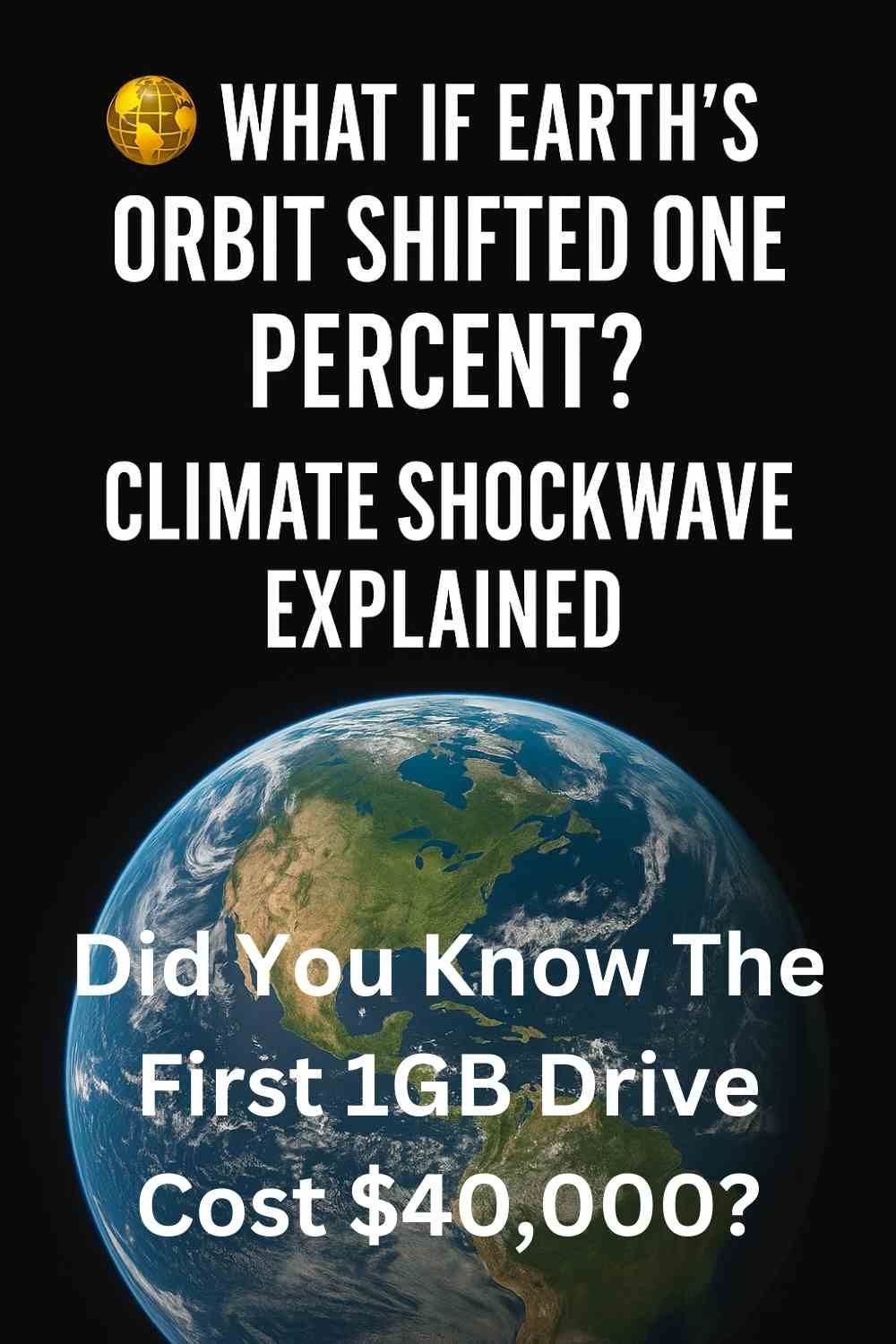What If Earth’s Orbit Shifted One Percent? Climate Shockwave Explained
A single percent doesn’t sound like much. One percent off your coffee order is a shrug. One percent off target in orbital mechanics is a global mood swing. If Earth drifted just 1% closer to or farther from the Sun, the incoming solar energy would jump or drop by roughly 2%. That’s not trivia. That’s climate history being rewritten—on the scale of ice ages and deglaciations.
 Let’s unpack what that actually means, without jargon soup, and with enough numbers to be honest about the uncertainty.
Let’s unpack what that actually means, without jargon soup, and with enough numbers to be honest about the uncertainty.
☀️ First Principles: How Big Is “1%” in Space?
Earth orbits at ~1 astronomical unit (AU) from the Sun: about 149.6 million km.
1% of that is ~1.5 million km. Picture sliding our entire planet that far inward or outward on a cosmic rail.
Why it matters: Solar energy falls off with the square of distance. Nudge inward by 1%, and the Sun looks ~2% “brighter” to Earth (technically, ~+2.0% in solar flux). Nudge outward by 1%, and it’s ~2% dimmer.
Quick energy translation:
Solar constant ≈ 1361 W/m².
±2% change ≈ ±27 W/m² at the top of the atmosphere.
Spread over the globe (divide by 4) and adjusted for Earth’s reflectivity (albedo ~0.30), that’s roughly ±4.7 W/m² of net energy change.
Climate folks usually talk in “radiative forcing.” For context, doubling CO₂ is about +3.7 W/m² and eventually ~+3°C of warming. So a 1% orbital shift inward is more energy than a CO₂ doubling. Outward is the same in reverse.
Ballpark global temperature response: ~±3.5 to ±4.0°C after the climate system settles (years to decades for the upper ocean; longer for the deep ocean and ice sheets).
That’s not a gentle nudge. That’s civilization-level planning territory.
🔥 If Earth Moves 1% Closer: A Hotter, Wetter, Meaner World
Headline number: ~+4°C global average warming after feedbacks play out.
What changes first?
Heat extremes: Heatwaves push into new latitudes. Places that already flirt with wet-bulb danger days (where sweat can’t cool you) would see them more often.
Rainfall shifts: A warmer world holds more moisture; heavy rainfall events intensify. Monsoon belts tend to widen and strengthen, but the exact winners and losers depend on land–sea contrasts and circulation quirks.
Wildfire risk: Hotter, drier seasons in key regions mean longer fire weather windows.
Cryosphere retreat: Mountain glaciers shrink faster; Greenland and West Antarctica lose mass more rapidly. Add thermal expansion of seawater and you’ve got accelerating sea-level rise.
Ecosystems on fast-forward: Species already living at the edge of their heat tolerance (coral reefs, alpine flora, boreal forests) face stepped-up stress tests. Expect poleward range shifts, mismatched seasonal timing (flowers vs. pollinators), and more invasive species.
Agriculture? It’s complicated. Growing seasons lengthen in some high-latitude zones, but heat stress and moisture volatility hammer yields in many breadbaskets. You don’t “out-irrigate” a megadrought.
❄️ If Earth Moves 1% Farther: A Colder, Harsher, Hungrier World
Flip the sign. Now we’re looking at ~−4°C global average after the system adjusts.
Longer winters, shorter summers across mid-latitudes.
More snow cover in shoulder seasons → higher reflectivity → amplified cooling (the classic snow–ice albedo feedback).
Glacier growth resumes in many ranges; sea level falls slowly if land ice grows enough to store water.
Storm tracks shift equator-ward; polar amplification still happens—but in reverse (the Arctic cools a lot).
Food risk rises: Shorter frost-free periods, more late-season frosts, and weaker monsoons threaten yields. Some regions gain reliability of moisture; many lose it.
Cooling is not a free air-conditioner. It’s a food-system stressor with real human costs.
🧮 Context Check: How “Ice-Age-Scale” Is This?
During the last glacial maximum, Earth was only about 5–6°C cooler globally than pre-industrial—but that was enough for ice sheets to bulldoze North America and Northern Europe. Our ±4°C back-of-envelope from a 1% orbital shift sits right in that neighborhood. Not identical, but same league.
And here’s a useful comparison:
CO₂ doubling (~+3.7 W/m²) → ~+3°C after full equilibration.
1% closer to the Sun (~+4.7 W/m²) → more warming than a CO₂ doubling.
1% farther → more cooling than removing a CO₂ doubling.
In other words: orbital percent-level shifts aren’t “small potatoes.” They’re climate drivers.
🧭 Will the Calendar Break? (Kepler Says… a Little.)
By Kepler’s third law, orbital period scales with the 3/2 power of the orbital radius.
1% farther → year lengthens by ~1.5% → about +5.5 days.
1% closer → year shortens by ~1.5% → about −5.5 days.
Day length (Earth’s rotation) doesn’t change because of this move, but we’d need to rewrite the calendar math. School years, fiscal quarters, sports seasons—all the human scaffolding tied to a 365-day rhythm—would need a tune-up.
Seasons are still driven by axial tilt, not distance, but now every season is bathed in more or less sunlight overall. Same choreography, brighter or dimmer stage lights.
🌊 Oceans: The Slow Giants Decide the Endgame
The atmosphere responds fast; the upper ocean takes years to decades; the deep ocean takes centuries. That matters:
Inward shift (warming): Stronger ocean stratification (layers don’t mix as well), which can trap heat near the surface, starve deeper waters of oxygen, and stress fisheries.
Outward shift (cooling): Weaker stratification in some basins may boost nutrient upwelling, but sea-ice expansion can also cap the ocean and alter circulation.
Currents change: The big highway systems—AMOC, the Indo-Pacific warm pool dynamics, Southern Ocean winds—rebalance. You feel that in rainfall belts and storm paths, not just in sea-surface temperature maps.
🌾 People, Infrastructure, and the Boring but Crucial Details
Energy systems: Warming world → soaring cooling demand, grid stress, more peak load in summer. Cooling world → heating demand spikes, especially in regions unequipped for long, deep winters.
Water: Monsoon shifts, snowpack changes, and altered evaporation turn familiar watersheds into gamble sheets. Reservoir rules, dam operations, and irrigation calendars need rewrites.
Insurance & finance: Risk models blow up if hazard frequency and intensity step outside observed ranges. Repricing hits coastal real estate in hot worlds and agricultural lands in cold ones.
Public health: Heat stress vs. cold-related mortality, vector-borne disease ranges moving, air-quality changes from fires or increased winter inversions.
The boring details decide budgets, not the headlines. And they all move when the orbit moves.
🧰 How Confident Is the Math?
This is energy-balance physics 101 plus a healthy respect for feedbacks:
The ±4.7 W/m² forcing estimate from a ±2% insolation change is a straightforward calculation.
Turning forcing into temperature needs a climate sensitivity number. Use a conservative mid-range and you land near ±3.5–4.0°C.
Regional patterns are where complex models earn their keep. Some places warm or cool far more than the global average; others move less.
So treat the numbers as transparent ballparks, not prophecy.
🛰️ Is a 1% Orbital Shift Plausible Anytime Soon?
Short answer: No. Earth’s orbit does evolve over tens to hundreds of thousands of years (Milankovitch cycles), but those are changes in eccentricity, tilt, and precession, not a sudden 1% jog in the average distance. A crisp 1% semi-major-axis shift would take an extraordinary gravitational shove by something big and unfriendly. We’d have other problems first.
🧩 The Takeaway You Can Actually Use
One percent in space is civilization-scale on Earth.
Moving closer by 1% produces warming stronger than a CO₂ doubling.
Moving farther by 1% produces cooling on the order of ice-age steps.
Oceans, ice, and clouds decide the regional winners and losers, and that dance takes years to centuries.
Curious how sharp your space-and-climate instincts already are? Test yourself with the Bing Homepage Quiz challenge—it’s a fun way to cement the concepts you just met. And if you’re in the mood to keep your brain on a roll, explore more brain-stretchers at this curated quiz hub.
🧠 FAQ-Style Quick Hits
Does a 1% shift change day length?
No. That’s rotation, not revolution. Your 24 hours are safe.
Would seasons get “more extreme”?
Tilt still runs the show, but with more (or less) sunlight overall, every season shifts in the same direction—warmer if closer, cooler if farther. Regional extremes depend on circulation changes.
How fast would the climate respond?
Atmosphere: months to a few years. Upper ocean: years to decades. Ice sheets and deep ocean: decades to centuries. Society feels the first two timelines most.
Could we geoengineer our way out of it?
We could attempt to counter a warming shift with solar radiation management or a cooling shift with greenhouse gas additions—but those are blunt tools with side effects, governance headaches, and moral hazards. None are substitutes for stability.
🌐 Why This Thought Experiment Matters
You don’t need to fear a sudden orbital hiccup. The lesson is perspective. Small fractional changes in planetary energy—from distance, reflectivity, or greenhouse gases—can steer the entire climate. When we argue over a degree or two, we’re arguing about the difference between manageable and transformative. Between expensive and existential.
That’s the “shockwave” hidden inside one percent.

